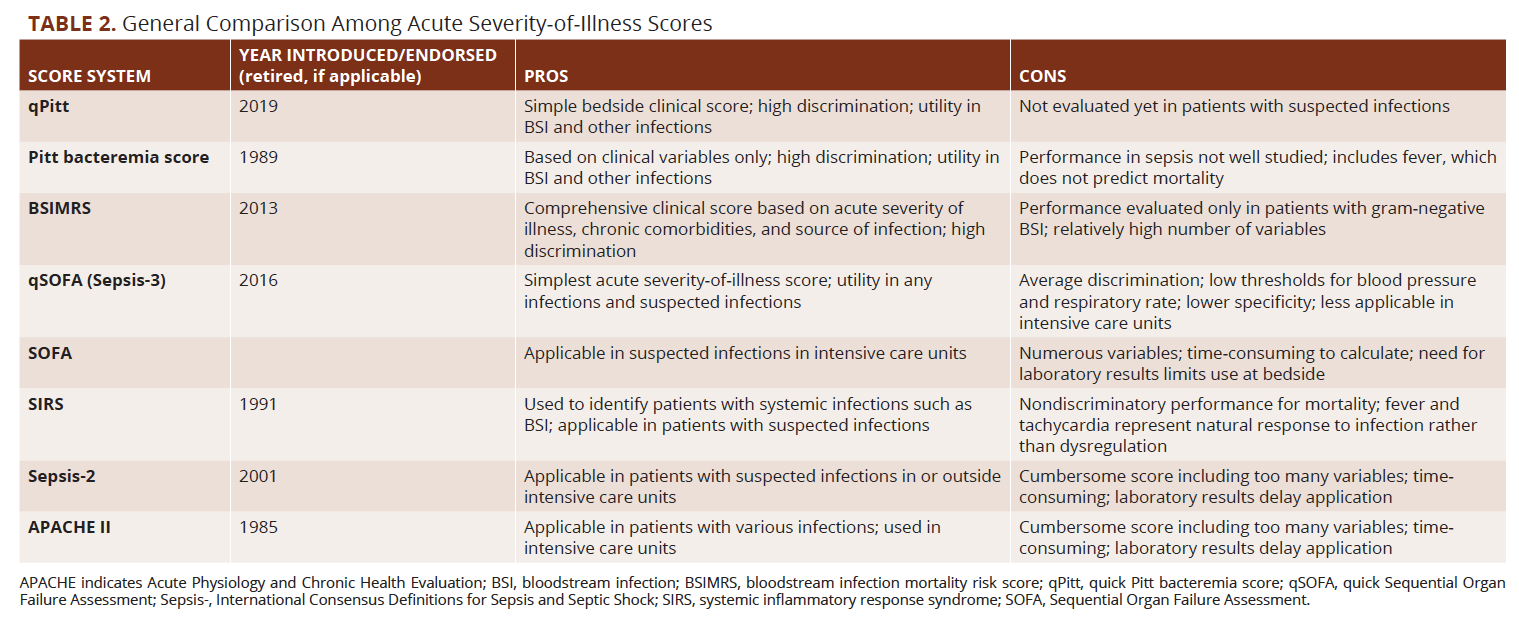Get Off the SOFA! Introducing the Quick Pitt Bacteremia Score
The quick Pitt Bacteremia Score offers accuracy comparable to the original version's across multiple infections, and maintains ease of use.
Scoring systems have been devel­oped and used for decades across a wide variety of ages and illnesses. These scores are intended to measure the degree of illness and provide meaningful predictions for clin­ical outcomes in order to allo­cate resources and guide care. Such systems are commonly used in infectious diseases to predict risks and severity of surgical site or Clostridioides difficile infections or assist clinicians at the point of care for diseases such as pneumonia, sepsis, or bacteremia.1-9
The focus of this article continues with the number of scoring systems that have been used in bacteremia and sepsis, in particular. Table 1 offers an overview of the clinical and laboratory criteria for select, commonly encountered scoring systems for acute severity of illness.4-11 Each scoring system brings certain advantages and disadvan­tages for clinical decision making (Table 2). The evolution of these scores has been observed in peer-reviewed litera­ture and national guidelines, most recently with the advent of the quick Sequential Organ Failure Assessment (qSOFA) score supported in the 2016 Surviving Sepsis Campaign.9-11 Although this is a simple bedside scoring system with no laboratory values required, there is a lack of universal support for this score among leading experts in the field.12 We will describe the development of a simplified bedside scoring tool derived from the original Pitt bacteremia score (PBS), also referred to as the quick PBS or qPitt.

EVOLUTION OF THE PITT BACTEREMIA SCORE
Since its inception in 1989, the PBS has been used in numerous pivotal studies of bloodstream infections (BSIs). It has outperformed more complex scores of acute severity of illness in predicting mortality in various clin­ical settings. Among its other advantages, the PBS is solely based on clinical variables and lacks any laboratory criteria. This means it may be applied immediately at the bedside without the need to wait for blood collection or laboratory results.
During the first decade of the PBS usage, point alloca­tion for temperature underwent several revisions.13 This is conceivable because fever represents a natural response to systemic infections, including BSI, and is not a consistent predictor of mortality. On the other hand, hypothermia (temperature <36° C) constitutes a dysregulated host response to infection and has been associated with high risk of mortality in patients with BSI.
DERIVATION OF THE QUICK PITT BACTEREMIA SCORE
Despite its relative simplicity, the PBS may still require some reference of the score’s criteria and take some thought to calculate. A quick form of the PBS (qPitt) was developed to further simplify the score by using only binary variables and allocating 1 point for each variable.14 This was achieved by either merging categorical into binary variables or eliminating variables that did not predict mortality. This also provided an opportunity to reexamine fever and allowed earlier detection of respiratory failure prior to mechanical ventilation.
In the derivation study of the qPitt, Battle and colleagues examined clinical risk factors for 14-day mortality in patients with gram-negative BSI.14 This retrospective cohort study included 832 patients hospitalized with gram-negative BSI at Prisma Health—Midlands hospitals in South Carolina over a 4-year period. All variables in the PBS were independently associated with 14-day mortality except fever (temperature >39° C). In addition, respiratory rate (≥25 breaths/minute) was associated with 14-day mortality.
After adjustment in a multivariate model, hypo­thermia, systolic blood pressure of <90 mm Hg or vasopressor use, respiratory rate of >25 breaths/minute or mechanical ventilation, cardiac arrest, and altered mental status were independently associated with 14-day mortality and were included in the qPitt.
The worst (highest or lowest) variables collected 24 hours prior and 24 hours following the collection of index blood culture were used. The qPitt had good discrimination (area under the receiver operating charac­teristic curve [AUROC], 0.85) and performed better than both qSOFA (0.77) and systemic inflammatory response syndrome (SIRS) score (0.63) in predicting 14-day mortality following gram-negative BSI. A score of 2 was found to be the best cutoff value in the qPitt. A qPitt ≥2 was clinically useful in identifying criti­cally ill patients in whom appropriate empir­ical antibiotic therapy was associated with improved survival.14
THE ROLE OF QPITT IN STAPHYLOCOCCUS AUREUS BACTEREMIA
In a more recent study presented at IDWeek 2019, Battle and colleagues evalu­ated the qPitt’s performance in patients with Staphylococcus aureus BSI.15 The retrospec­tive cohort study included 398 hospitalized patients with S aureus BSI at Prisma Health— Midlands hospitals from 2015 through 2017. After adjustment for age, clinical, and micro­biological characteristics in the multivariate model, all 5 qPitt components were inde­pendently associated with 28-day mortality. Each point increase in the qPitt was associ­ated with a 3-fold increase in 28-day mortality (OR, 3.1; 95% CI, 2.4-4.0). In agreement with the previous study of gram-negative BSI, the qPitt had an AUROC of 0.82 for predicting 28-day mortality. A score of 2 was also the best cutoff value. Mortality was 8.7% in patients with a qPitt <2 and 57.5% in those with a score ≥2. As in the previous analysis, the qPitt in this study had a better predic­tive utility for mortality compared with qSOFA (AUROC, 0.82 vs 0.77, respectively).15
THE ROLE OF QPITT IN NONBACTEREMIC PATIENTS
A multicenter cohort study published in Clinical Infectious Diseases by Henderson and colleagues prospectively evaluated the predictive capabilities of the PBS and qPitt in patients with carbapenem-resistant Enterobacteriaceae (CRE) infec­tions, with or without BSI.16 Patients were included from the Consortium on Resistance Against Carbapenems in Klebsiella and Other Enterobacteriaceae (CRACKLE-1) study, for which the PBS and qPitt were calculated at baseline to predict 14-day mortality. Among patients with nonbacteremic CRE infections, the discrimination was similar between the PBS and qPitt scores (C-statistic for both, 0.85). A qPitt <2 and ≥2 represented the best cutoff values in the score similar to the 2 previous cohorts. The study validates both the PBS and qPitt in infected patients without BSI. It demonstrates that, like the PBS, the qPitt can be used at the bedside to predict mortality in patients with nonbacteremic infections using simple binary variables.16
APPLICATION AND FUTURE DIRECTIONS
The qPitt may be used at the bedside to determine acute severity of illness and predict mortality in patients with gram-negative or gram-positive BSI, as well as other infections. The qPitt combines the best of both the PBS and the qSOFA. The PBS predicts mortality with high precision solely based on clinical criteria. Lack of laboratory variables makes it immediately applicable at the bedside, with no need to wait for laboratory results. This is a major advantage over comparator scores. However, it requires some effort to calculate, given various point allocations for categorical variables.
On the other hand, the qSOFA is the simplest clinical score out there; however, it lacks the high discrimination of the PBS based on several studies in various clinical settings. Despite the endorsement in the Third International Consensus Definitions for Sepsis and Septic Shock (Sepsis-3),17 many clinicians, scientific societies, and health care organi­zations remain reluctant to implement the qSOFA. The qPitt predicts mortality with an accuracy comparable to the PBS, while main­taining the simplicity and ease of use of the qSOFA. The qPitt offers an alternative clinical score to the qSOFA that is as simple but more precise in identifying patients at high risk of mortality. The qPitt shows notably higher discrimination than the qSOFA in predicting mortality following gram-negative and S aureus BSI, justifying its use in future investigations. Because the qPitt also performs well in other infections, it would be interesting to evaluate its ability to identify patients with life-threat­ening infections, such as sepsis, among those admitted to the hospital or intensive care units with suspected infections.
Williams is a fourth-year pharmacy student at the University of South Carolina (UofSC) College of Pharmacy in Columbia. His career interests include inpatient infectious diseases and critical care medicine.Bookstaver is an associate professor and director of residency and fellowship training in the Department of Clinical Pharmacy and Outcomes Sciences at UofSC College of Pharmacy. He also maintains a practice site in infectious diseases at Prisma Health Richland, where he serves as director of the infectious diseases PGY-2 residency program and clinical fellowship program.*Denotes active members of the Society of Infectious Diseases Pharmacists (SIDP).
References:
- Campwala I, Unsell K, Gupta S. A comparative analysis of surgical wound infection methods: Predictive values of the CDC, ASEPSIS, and southampton scoring systems in evaluating breast reconstruction surgical site infections. Plast Surg (Oakv). 2019 May;27(2):93-9. doi: 10.1177/2292550319826095.
- Niederman MS. Making sense of scoring systems in community acquired pneumonia. Respirology. 2009 Apr;14(3):327-35. doi: 10.1111/j.1440-1843.2009.01494.x.
- Miller MA, Louie T, Mullane K, et al. Derivation and validation of a simple clinical bedside score (ATLAS) for clostridium difficile infection which predicts response to therapy. BMC Infect Dis. 2013 Mar 25;13:148. doi: 10.1186/1471-2334-13-148.
- Knaus WA, Draper EA, Wagner DP, et al. APACHE II: a severity of disease classification system. Crit Care Med. 1985;13:818.
- Al-Hasan M, Lahr B, Eckel-Passow J, Baddour L. Predictive scoring model of mortality in gram-negative bloodstream infection. Clin Microbiol and Infect. 2013;19(10):948-954. doi:10.1111/1469-0691.12085.
- Levy MM, Fink MP, Marshall JC, et al. 2001 SCCM/ESICM/ACCP/ATS/SIS international sepsis definitions conference. Intensive Care Med. 2003;29(4):530-8. doi:10.1007/s00134-003-1662-x.
- American College of Chest Physicians/Society of Critical Care Medicine Consensus Conference: definitions for sepsis and organ failure and guidelines for the use of innovative therapies in sepsis. Crit Care Med. 1992;20(6):864-874. doi:10.1097/00003246-199206000-00025.
- Seymour CW, Liu VX, Iwashyna TJ, et al. Assessment of Clinical Criteria for Sepsis: For the third international consensus definitions for sepsis and septic shock (sepsis-3). JAMA. 2016; 315(8):762-74. doi:10.1001/jama.2016.0288.
- Rhodes A, Evans LE, Alhazzani W, et al. Surviving sepsis campaign: International guidelines for management of sepsis and septic shock: 2016​. Crit Care Med. 2017; 45(3):486-552. doi: 10.1097/CCM.0000000000002255.
- Breslow MJ, Badawi O. Severity scoring in the critically ill: Part 1--interpretation and accuracy of outcome prediction scoring systems. Chest. 2012 Jan; 141(1):245-252. doi: 10.1378/chest.11-0330.
- Keegan MT, Gajic O, Afessa B. Severity of illness scoring systems in the intensive care unit. Crit Care Med. 2011 Jan;39(1):163-9. doi: 10.1097/CCM.0b013e3181f96f81.
- Al-Hasan MN, Justo JA. Ignoring the elephant: does the infectious diseases society of america support sepsis-3 or pre-sepsis criteria? Clin Infect Dis. 2018. doi: 10.1093/cid/ciy678.
- Al-Hasan MN, Baddour LM. Resilience of the pitt bacteremia score: Three decades and counting. Clin Infect Dis. 2019. doi: 10.1093/cid/ciz535. [Epub ahead of print].
- Battle SE, Augustine MR, Waton CM, et al. Derivation of a quick pitt bacteremia score to predict mortality in patients with gram-negative bloodstream infection. Infection. 2019; 47(4):571-8. doi: 10.1007/s15010-019-01277-7
- Battle SE, Justo JA, Bookstaver PB, Kohn J, Al-Hasan M. Validation of quick pitt bacteremia score in patients with staphylococcus aureus bloodstream infection. Presented at IDWeek 2019, Washington DC, October 3, 2019. Abstract 851.
- Henderson H, Luterbach CL, Cober E, et al. The pitt bacteremia score predicts mortality in non-bacteremic infections. Clin Infect Dis. 2019 Jun 19. doi: 10.1093/cid/ciz528. [Epub ahead of print]
- Grissom CK, Brown SM, Kuttler KG, et al. A modified sequential organ failure assessment (MSOFA) score for critical care triage. Disaster Med Public Health Prep 2010;4(4):277-84. doi: 10.1001/dmp.2010.40.
- Singer M, Deutschman CS, Seymour CW, et al. The third international consensus definitions for sepsis and septic shock (sepsis-3). JAMA. 2017; 315(8):801-10. Doi: 10.1001/jama.2016.0287

